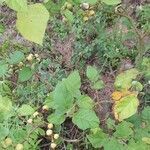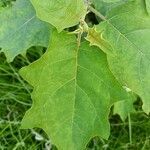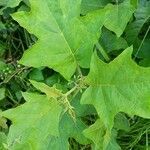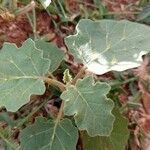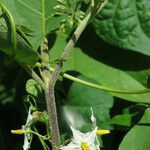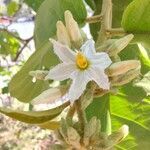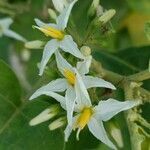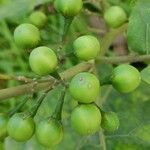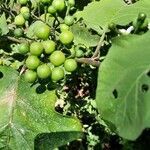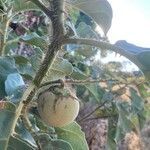Shrub or tree to 6 m tall; twigs tomentose with mostly stalked, porrect stellae, the midpoints much reduced and eglandular; armed with short straight or re-curved spines which may be pubescent basally. Leaves to 25 cm long, broadly ovate, apically deltoid, basally obtuse or cordate, often dimidiate, the margins sinuate-dentate, above with dispersed stalked or sessile, porrect hairs, the mid-points as long as the radii or longer, beneath tomentose with mostly stalked, porrect hairs, the midpoints reduced, rarely armed on the veins; petioles 1-10 cm long. Inflorescence several-to many-flowered; peduncle tomentose, usually once-branched less than 1 cm from the base, the racemes mostly 1-2 cm long; pedicels 1-1.5 cm long, very slender, purple, drying dark, hispid-viscid with mostly glandular, simple hairs and some porrect stellae with long glandular mid-points, elongating and becoming stout in fruit. Flowers with the calyx purplish, 5 mm long, the lobes ca. 1 mm long and lengthening as the glabrous sinuses dehisce during corolla egress, viscid-hispid outside, glabrous within; corolla white, 1.5-3 cm across, shallowly lobed; filaments glabrous, the anthers 7-12 mm long, often oblique basally, tapering to a fine point and dehiscing by minute terminal pores; ovary with short, glandular, simple hairs near the apex, the style glandular-hairy near the base. Fruit a globose berry 1-1.5 cm across, glabrous, mucilaginous, erect, yellow, but seldom seen when mature; seeds flattened-discoid, 1.5-2 mm across.
Shrubs 1-2(-3) m tall, sparingly armed, densely pubescent overall with many-rayed, grayish stellate hairs. Stems with stout, recurved, reddish or pale-yellow prickles 2.5-10 × 2-10 mm and sometimes bearing basal stellate hairs. Leaves solitary or paired; petiole 2-4 cm; leaf blade ovate to elliptic, 6-16(-19) × 4-11(-13) cm, with yellow, many-branched stellate hairs, armed or unarmed, base cordate or cuneate, margin sinuate or usually 5-7-lobed, apex acute. Inflorescences extra-axillary, many-flowered racemose panicles; peduncle mostly 1-or 2-branched, 1-1.8 cm, stellate pubescent. Flowers andromonoecious. Pedicel dark, slender, 5-12 mm, bearing simple glandular hairs and stalked stellate hairs. Calyx cup-shaped, 4-5 mm, pubescence as on pedicel; lobes ovate-lanceolate, 2-3 mm. Corolla white, rotate, 1-1.3 × 1-1.5 cm; lobes ovate-lanceolate, 8-10 mm, stellate pubescent abaxially. Filaments ca. 1 mm; anthers 4-7 mm. Style 6-8 mm. Fruiting pedicel 1-2 cm, thickened upwards, with sparse stellate and simple glandular hairs. Fruiting calyx ca. 1.5 cm. Berry yellow, smooth, glabrous, 1-1.5 cm in diam. Seeds discoid, 1.5-2 mm in diam. Fl. and fr. throughout the year.
Spreading or scrambling shrub to 3 m high, dark green, pubescent with stellate hairs; hairs dense on lower leaf-surface, sparser on upper surface; glandular hairs on pedicels; prickles 3–7 mm long, scattered on stems and leaf-surfaces, sparse to absent on mature growth. Leaves broadly oval-ovate; lamina mostly 10–15 cm long, 8–10 cm wide, discolorous, lobed; lobes broadly triangular; petiole usually 2–5 cm long. Inflorescence usually branched, 50–100-flowered, the upper and late-season flowers often male; peduncle to first fork 10–25 mm long; pedicels 5–10 mm long, slightly longer in fruit. Calyx 3–5 mm long; lobes apiculate, 2–3 mm long. Corolla stellate, deeply incised, 20–25 mm diam., white. Anthers 5–7.5 mm long. Berry globular, 10–15 mm diam., drab yellow, drying black. Seeds 1.5–2 mm long, yellow or drab brown.
Leaves often geminate at least upwards; petiole 0.8–3.8 cm long; lamina somewhat felty, 4.5–15 × 2.5–11 cm, broadly ovate, ovate-rhombic or ± elliptic, base usually ± cordate or truncate, often dimidiate, apex obtuse to acute, occasionally somewhat acuminate, usually sinuate to lobed, the lobes up to 7, broadly angular or somewhat triangular to rounded, acute to rounded, the sinuses rounded between the lobes, pubescent to scabrous above, the hairs often long stalked with long lateral rays and a short central ray, lower surface paler, densely greyish-white-ochraceous or rusty-ochraceous tomentose to shortly pubescent, with 4–5 pairs of ± straight, lateral nerves, unarmed or with a few straight prickles on the nerves beneath.
Cymes lateral, leaf-remote, axillary or extra-axillary, but ± erect and generally borne above the leaf canopy, once-forked to several times branched, ± corymbiform, at first sub-umbelliform, 1.5–3 cm across, ± congested, few to many-flowered, generally maturing numerous fruits, greenish-white-ochraceous or ochraceous-rusty tomentose, with simple, glandular hairs interspersed, nearly always unarmed, upper and late-season flowers male, lower flowers hermaphrodite; peduncle 0–0.5(1) cm long.
Ovary 0.7–1 mm long, globose or ± conical (or sometimes oblong in outline), sub-sulcate at the middle, reduced in male flowers, glabrous to finely covered with short, simple, glandular hairs denser near the top; style 8–10 mm long, exceeding the stamens, curved, finely glandular-pubescent near the base, exserted, greatly reduced in male flowers and included within the connivent anthers.
Spreading or scrambling shrub or small tree up to 3(6) m, armed; hairs stellate, sessile to long stalked, regular or irregular, with numerous thin rays, or simple apically glandular, spreading hairs interspersed; prickles sub-fuscous, 3–7 mm long and 1–7 mm wide at the base, laterally compressed, broad based, straight or slightly recurved, apically subulate, basally hairy to glabrous.
A shrub 1.5-3 m high. The leaves are oblong and 10-25 cm long. They can be entire or lobed. They often have prickles beneath the midrib. The young stem and underside of leaves are hairy. The flower is white and 2 cm across. The fruit are round berries, yellow when ripe. They are about 1 cm across. They grow in clusters. The seed are roughly circular and 2-3 mm across.
Calyx green or purplish, 3–4 mm long, 5–6 mm across, cupular, often deeply lobed, not very accrescent, glandular-pubescent or hispid-viscid; lobes unequal, 1.5–2.5 × 1–1.5 mm, ovate or triangular to lanceolate, acute or apiculate to long-acuminate, in fruit enlarged to 4 × 2.5 mm, curved out at the apex, the sinuses glabrous and splitting as the corolla expands.
Corolla white or occasionally lilacineous, rotate to stelliform; limb 1.5–2(3) cm across; lobes 4–6 × 4–6 mm, ovate-lanceolate or lanceolate, obtuse or acute to acuminate, undulate at the margins, hairy or tomentose outside on the median region, ± glabrous inside, spreading, connate by membranous sinuses.
Flowers 5-merous; pedicels (4)5–8(10) mm long, slender, glandular-pubescent or hispid-viscid, in fruit elongated to 20 mm, becoming stout and somewhat thickened distally.
Seeds drab brownish, numerous, 1.5–3 mm in diameter, compressed, somewhat angular, reniform or discoid, smooth to slightly granular all over.
Stamen filaments 1–2 mm long; anthers (5)6–8 mm long, linear-lanceolate in outline, oblique basally, connivent into a cone.
Fruits greenish, turning yellowish, drab yellow or dirty-brown when ripe, 8–15 mm in diameter, globose, eaten in curry.
Branches whitish to ochraceous-rusty tomentose, ultimately glabrescent, with scattered prickles.
A shrubby weed attaining 10 ft. or more in height
Pale stellate-tomentose
White or lilac flowers
Fruits 1/3 in. diam.
Flattened spines
